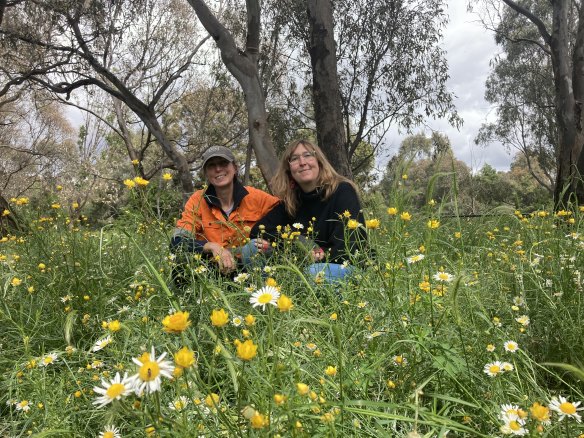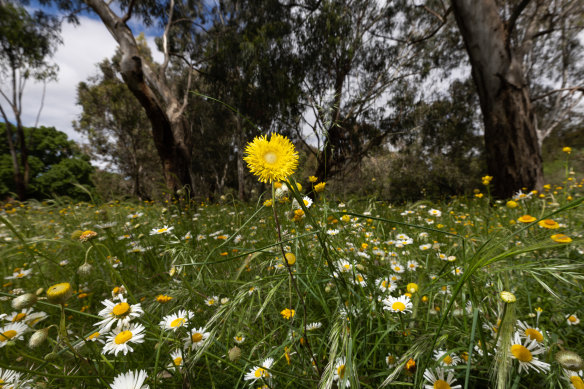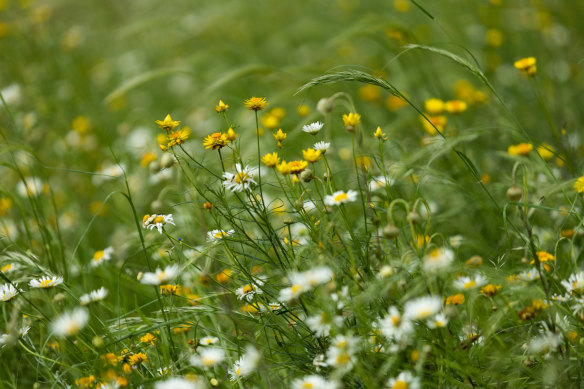This was published 2 years ago
How flower-filled grasslands are finding their way into Melbourne’s CBD
In April 2020, in the full throes of the pandemic, Katherine Horsfall began an experiment. She wanted to see whether she could turn a barren ribbon of land in Parkville into loose, lively drifts of wildness.
She was imagining something altogether richer and freer than the heavily mulched but sparsely planted public landscapes that generally abound in the city. She envisaged a ground flora so diverse that more than 20 different species would exist within a single square metre.

Sophia Blosfelds (left) and Katherine Horsfall amid their Parkville plantingsCredit: Megan Backhouse
The natural temperate grasslands that once spread from the Yarra River in Melbourne to the South Australian border were what Horsfall, a researcher at the University of Melbourne, had in mind when she scraped back the pure, unadulterated woodchips weaving around River Red Gums down one side of Gatehouse Street.
In place of the chips she sowed about one million seeds of 27 indigenous grasses and wildflowers. And because this was an experiment – being run by the University of Melbourne together with the City of Melbourne – she sowed her seeds into an assortment of different beds.
You might remember Horsfall from when this masthead first spoke to her six months after planting. Then, she was still at the “nerve-wracking” stage. Her seeds had formed seedlings just large enough to be identifiable but she was yet to see a lush, immersive expanse brimming with plants.
But go to the site now and it is a different story. You will find almost no areas of open soil. Instead, complex mixes of grasses and flowers sway in the wind and change colour with the seasons. They look elegant and dynamic and, crucially for a public landscape, they are also relatively low care.

The flowers and grasses look like wild nature but are just 3km from the CBD.Credit: Jason South
While there was regular hand weeding and irrigation during the first year of establishment, the beds have since been given a more hands-off approach, one that, aside from some hand weeding, essentially consists of annual slashing that emulates the role of fire in a natural system.
It’s hard to differentiate between the different treatments now, but what Horsfall’s experiment found was that the beds covered with 80mm of a free-draining, nutrient-poor, sharp sand before sowing were the easiest to manage.
While the plants were slower to establish on this depth of sand compared to the plants sown in only 10mm of sand, Horsfall says “significantly” less weeds emerged during the first year of establishment “representing cost savings to public land managers looking to replicate this kind of work elsewhere”.

There are almost no areas of open soil.Credit: Jason South
Moreover, within 12 months any differences in plant cover and species diversity across the different depths of sand had gone.
Horsfall and other researchers are now looking at what else can be done to ensure these meadows are even more diverse, sustainable and replicable because one of the central aims of this project is to create something that can be copied. Imagine if all the lashings of woodchip mulch spread around Melbourne were replaced with rich, resilient understory plantings.
At the Burnley campus, researchers are now looking at how waste subsoils might be used as a more sustainable low-nutrient alternative to mined sand, and also thinking about the potential of such recycled mineral wastes as crushed concrete.
Meanwhile in May this year, University of Melbourne masters research student Sophia Blosfelds took over another 2100 square metres of land running along Gatehouse Street and started a new experiment.
Blosfelds covered her beds with 50mm of sand, sowed three different seed mixes and is now waiting to see how much seed these sort of plantings could provide seed for future landscapes. This is important because sourcing seeds is a complicating factor in gardening like this.
Not only does the severe depletion of grasslands in the wild make it difficult to sustainably collect them from remnant patches, many of these seeds are not widely commercially available. Both Blosfelds and Horsfall relied on seed raised from containerised growing systems that Horsfall first established at the Burnley campus.
Blosfelds, who even after contending with below-average sunshine, above-average rain and an outbreak of redlegged earth mite, has – in just six months – established a landscape that looks like wild nature barely three kilometres from the CBD, will be running a vacuum seed harvester over her beds from late December.
In the meantime passersby are reaping the benefits. “Ninety nine per cent of people are encouraging and positive,” Blosfelds says. “These plants are inherently beautiful and bringing them up close and personal can play an educative role as well as an aesthetic role.”
Lord Mayor Sally Capp is happy with them too. She says they attract pollinators, beautify the city and, by incorporating threatened indigenous plants species, “add a layer of cultural and biological significance”.
Make the most of your health, relationships, fitness and nutrition with our Live Well newsletter. Get it in your inbox every Monday.